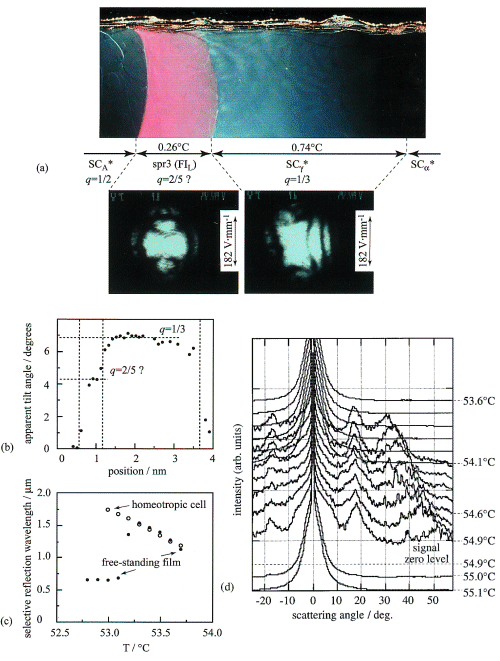
Additions and corrections
A novel property caused by frustration between ferroelectricity and antiferroelectricity and its application to liquid crystal displays – frustoelectricity and V-shaped switching
Takahiro Matsumoto, Atsuo Fukuda, Masahiro Johno, Yuki Motoyama, Tomoyuki Yui, San-Seong Seomun and Mamoru Yamashita
J. Mater. Chem., 1999, 9, 2051-2080
Part (d) of Fig. 8 of this paper was unfortunately omitted from the printed article. The complete figure and its caption are reproduced here:

Fig. 8 A helicoidal ferrielectric phase in spr3 (q = 2/5?) observed in compound 8.50 (a) A micrograph of a ca.100 μm thick free-standing film under temperature gradient and characteristic conoscopic figures under applied electric fields in FIL (q = 2/5?) and SCμ* (q = 1/3); (b) Apparent tilt angle vs. temperature (position in the micrograph (a)) determined by measuring center-shift of conoscopic figures under an applied electric field; (c) Temperature variation of selective reflection peaks due to the FIL and SCμ* helicoidal structures; (d) Laser light diffraction patterns obtained at various temperatures in a 350 μm thick cell aligned homogeneously using a magnetic field. The patterns are shown at 0.1 °C intervals and their ordinate zeros are shifted upwards constantly by one division.
In Table 4 (on page 2077), the last four entries beneath the column headings "Mixture no." and "Mixing ratios/mol" were incorrect, and should read as follows:
| Mixture no. | Mixing ratios/mol |
| 4e-E1 | 4-1C : 4e-2A = 80 : 20 |
| 4f-E1 | 4-1C : 4f-2A = 80 : 20 |
| 4g-E1 | 4-1C : 4g-2B = 80 : 20 |
| 4-1C |
The rest of the Table is unaltered.